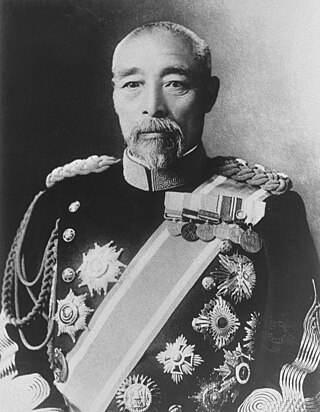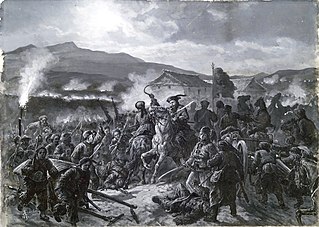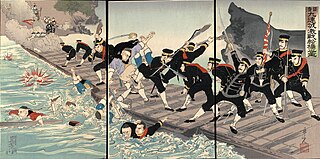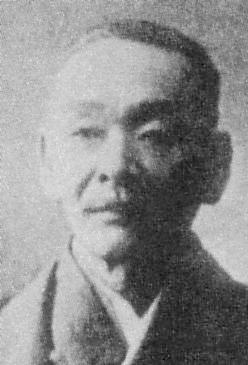Biography
Paine graduated magna cum laude from Harvard University in 1979 with a BA in Latin American studies. She spent ten years acquiring her PhD in Russian and Chinese history at Columbia University,which included five years of research and language study in China,Taiwan,Russia,Japan,and Australia. [1] [2] She has received two Title VIII fellowships from the Hoover Institution, [3] two Fulbright fellowships,and other fellowships from Japan,Taiwan,and Australia. [1] She began her career at the Naval War College as an associate professor starting in 2000 and is now a professor of history and grand strategy. [4]
She is married to Bruce A. Elleman,a professor at the U.S. Naval War College. [5] She has two brothers –John B. Paine III,and Thomas M. Paine. [6]

The First Sino-Japanese War or the First China–Japan War was a conflict between the Qing dynasty and the Empire of Japan primarily over influence in Korea. After more than six months of unbroken successes by Japanese land and naval forces and the loss of the port of Weihaiwei, the Qing government sued for peace in February 1895.

The Battle of the Yalu River was the largest naval engagement of the First Sino-Japanese War, and took place on 17 September 1894, the day after the Japanese victory at the land Battle of Pyongyang. It involved ships from the Imperial Japanese Navy and the Chinese Beiyang Fleet.

The Treaty of Aigun was an 1858 treaty between the Russian Empire and Yishan, official of the Qing dynasty of China. It established much of the modern border between the Russian Far East and China by ceding much of Manchuria, now known as Northeast China. Negotiations began after China was threatened with war on a second front by Governor-General of the Far East Nikolay Muraviev when China was suppressing the Taiping Rebellion. It reversed the Treaty of Nerchinsk (1689) by transferring the land between the Stanovoy Range and the Amur River from the Qing dynasty to the Russian Empire. Russia received over 600,000 square kilometers (231,660 sq mi) of what became known as Outer Manchuria. While the Qing government initially refused to recognize the validity of the treaty, the Russian gains under the Treaty of Aigun was affirmed as part of the 1860 Sino-Russian Convention of Peking.

CountOku Yasukata was a Japanese field marshal and leading figure in the early Imperial Japanese Army.

Admiral Ding Ruchang was a Chinese military officer in the late Qing dynasty.

Yaeyama (八重山) was an unprotected cruiser of the Imperial Japanese Navy. The name Yaeyama comes from the Yaeyama Islands, the southernmost of the three island groups making up current Okinawa prefecture. Yaeyama was used by the Imperial Japanese Navy primarily as an aviso for scouting, reconnaissance and delivery of high priority messages.

Takao (高雄) was an unprotected cruiser of the Imperial Japanese Navy. The name Takao comes from the Mount Takao, near Kyoto. Takao was used by the Imperial Japanese Navy primarily as an aviso or dispatch boat, for scouting, reconnaissance and the conveying of important messages.

Yoshino (吉野) was a protected cruiser of the Imperial Japanese Navy. Yoshino is sometimes regarded as a sister ship to Takasago, although the two vessels are of different classes. The name Yoshino comes from the Yoshino mountains, located in the southern portion of Nara prefecture. She played an important role in the First Sino-Japanese War, but was sunk in the Russo-Japanese War after being rammed by Japanese armored cruiser Kasuga in dense fog.

Marshal-Admiral Count Itō Sukeyuki was a Japanese career officer and admiral in the Imperial Japanese Navy in Meiji-period Japan.

CountKabayama Sukenori was a Japanese samurai military leader and statesman. He was a general in the Imperial Japanese Army and an admiral in the Imperial Japanese Navy. He later became the first Japanese Governor-General of Taiwan during the island's period as a Japanese colony. He is also sometimes referred to as Kabayama Motonori.

The Battle of Pyongyang was the second major land battle of the First Sino-Japanese War. It took place on 15 September 1894 in Pyongyang, Korea between the forces of Meiji Japan and Qing China. It is sometimes referred to archaically in Western sources as the "Battle of Ping-yang". Between 13,000 and 15,000 Chinese troops of the Beiyang Army under overall command of General Ye Zhichao had arrived in Pyongyang on 4 August 1894, and had made extensive repairs to its ancient city walls, feeling itself secure in its superior numbers and in the strength of the defenses.

The Battle of Seonghwan was the first major land battle of the First Sino-Japanese War. It took place on 29 July 1894 at the hamlet of Seonghwan, outside of Cheonan, Chungcheongnam-do Korea between the forces of Meiji Japan and Qing China. It is also referred to as the Battle of Asan.

The Battle of Weihaiwei (Japanese: Ikaiei-no-tatakai took place between 20 January and 12 February 1895, during the First Sino-Japanese War in Weihai, Shandong Province, China, between the forces of Japan and Qing China. In early January 1895, the Japanese landed forces in eastern Shandong positioning forces behind the Chinese naval base at Weihaiwei.

The Battle of Jiuliancheng (九連城之戰) was a land battle of the First Sino-Japanese War between the forces of Meiji Japan and Qing China. It is sometimes referred to as the Battle of the Yalu River, thus creating confusion with the previous naval conflict of the same name of 17 September, and the subsequent naval and ground battles of the Russo-Japanese War, with the same name and occurring at much the same location.

Baron Nishi Tokujirō was a statesman and diplomat in Meiji period Japan.
Catherine Zara Raymond is an international maritime security expert. She is an Associate at the Corbett Centre for Maritime Policy Studies, based at the Joint Services Command and Staff College, Defence Academy of the United Kingdom.
The recorded military history of China extends from about 2200 BC to the present day. This history can be divided into the military history of China before 1912, when a revolution overthrew the imperial state, and the period of the Republic of China Army and the People's Liberation Army.
This is a list of events in the year 1894 in Japan. It corresponds to Meiji 27 (明治27年) in the Japanese calendar.
Ye Zhichao was a Chinese general of the Qing Dynasty who fought in the First Sino-Japanese War, being the commander of Qing forces stationed in Korea.

The Japanese Empire: Grand Strategy from the Meiji Restoration to the Pacific War is a 2017 history book by S. C. M. Paine about the Empire of Japan. The Japanese Empire is the most recent publication by Paine, after 2012's The Wars for Asia, 1911–1949. Unlike her previous works, this book focuses chiefly on Japan, whereas her other works had instead focused on Russia or China.















